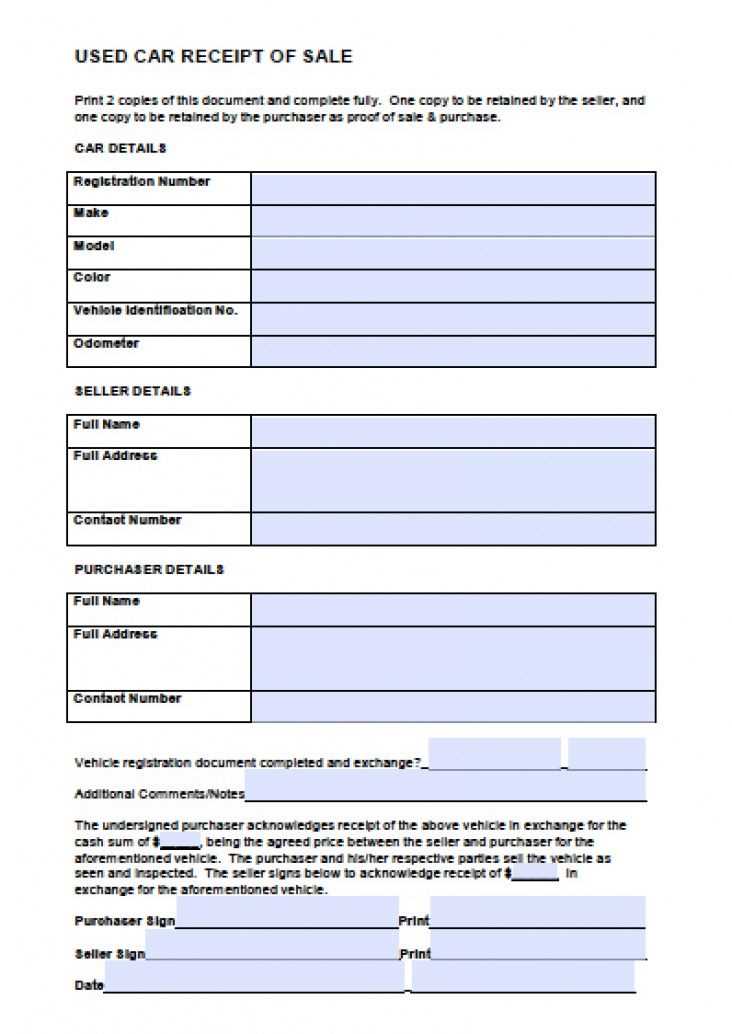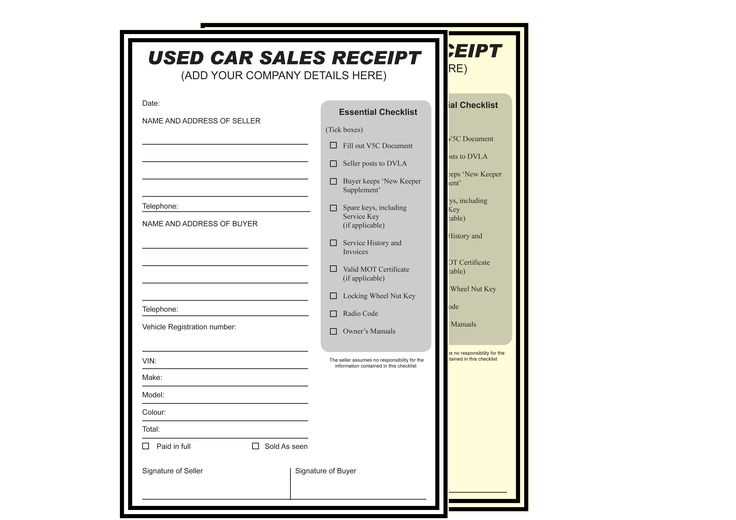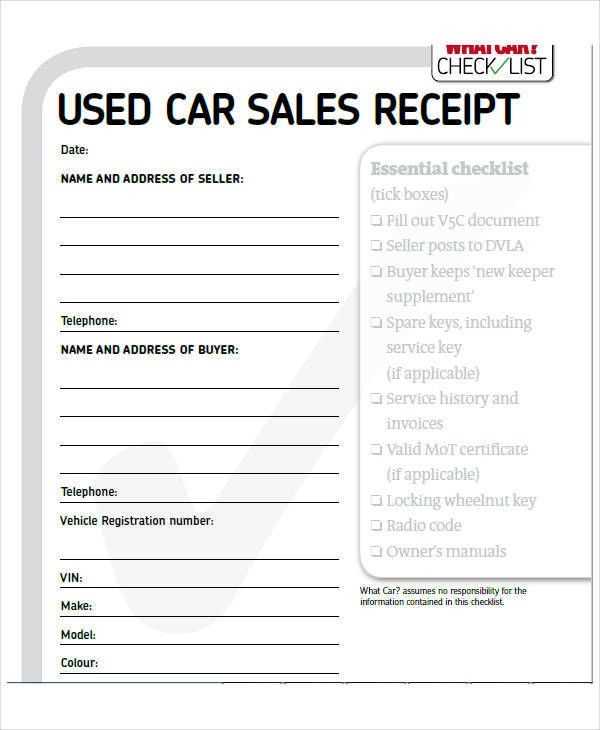
Ensure a smooth and clear transaction by using a car private sale receipt template. This document serves as a formal record of the sale, providing both the buyer and seller with vital information about the car and the terms of the sale. It’s essential to have all the necessary details in one place to avoid any misunderstandings later on.
Start with the basic information: the vehicle details such as make, model, year, VIN (Vehicle Identification Number), and odometer reading at the time of sale. This ensures that both parties are on the same page about the car’s identity. Include the sale price clearly, as well as the payment method, whether it’s cash, bank transfer, or another form of payment.
Don’t forget to specify the date of sale and any warranties or disclaimers about the condition of the car. If the car is sold as-is with no warranty, make sure this is stated clearly to protect both parties from future claims. Finally, include both the buyer’s and seller’s contact information and signatures to confirm the transaction.
Here are the corrected lines:
Ensure the seller’s full name and address are listed clearly, along with the buyer’s information. Include a section for the vehicle details: make, model, year, VIN (Vehicle Identification Number), and odometer reading. Specify the agreed price and method of payment.
In the “Vehicle Condition” section, provide an honest description of any damages, repairs, or modifications. If the sale includes any warranties or guarantees, note the details here, including the duration and coverage.
Confirm the seller’s declaration that the vehicle is sold “as-is,” unless any warranty is provided. Clearly state that the buyer has inspected the vehicle and accepts its condition. Add a section for both parties to sign, with date fields for legal validity.
Ensure both parties acknowledge and sign in the presence of a witness, if required. Keep a copy of the receipt for both parties. Make sure that the language is clear and the terms are unambiguous to avoid future disputes.
- Car Private Sale Receipt Template
For a smooth car sale process, a private sale receipt is a critical document to finalize the transaction. It ensures both buyer and seller have proof of the sale and helps avoid any future disputes. Here’s how you can structure an effective receipt:
Key Information to Include

The receipt should clearly list the following details:
- Seller’s Full Name and Contact Information: Ensure the seller’s name, address, and phone number are correctly listed.
- Buyer’s Full Name and Contact Information: Include the buyer’s full name and contact details.
- Vehicle Information: Include the make, model, year, Vehicle Identification Number (VIN), and license plate number.
- Sale Date: Clearly state the date of the transaction.
- Sale Price: The agreed-upon price of the car, with both the amount in words and numbers.
- Odometer Reading: The vehicle’s mileage at the time of the sale.
Additional Considerations

Including the following can help make the receipt more complete:
- Payment Method: Indicate whether payment was made via cash, bank transfer, or another method.
- Seller’s Warranty or “As Is” Clause: Specify whether the car is sold with a warranty or “as is.” The latter protects the seller from liability for future issues.
- Signatures: Both the seller and
- Key Elements to Include in a Private Sale Receipt
- How to Ensure Legal Validity of a Sale Receipt
- Write down the agreed sale price and payment method.
- Include the sale date and any relevant conditions, such as warranties or return policies, if applicable.
- Clearly state that the car is sold “as is,” if that is the case.
- Tips for Customizing a Receipt Template for Your Transaction
Begin with clear identification of both the buyer and the seller. Include full names, addresses, and contact information to ensure both parties are identifiable. Include the car’s detailed information such as make, model, year, VIN (Vehicle Identification Number), and odometer reading to avoid any confusion about the vehicle in question.
State the agreed sale price and the method of payment, whether it is a lump sum or installments. If a deposit is involved, make sure to specify that amount and its date. This helps clarify the financial agreement.
Specify the sale condition–whether the vehicle is sold “as-is” or with any warranties. If warranties apply, include details on the duration and type of coverage. If no warranty is provided, note this clearly.
Include the date of the transaction along with the expected title transfer date. This establishes the timeline for both parties.
Lastly, ensure both parties sign the receipt. The buyer and seller should sign to confirm the sale and validate the agreement. Each signature makes the transaction legally binding and protects both parties in case of disputes.
To ensure the legal validity of a car sale receipt, make sure the document includes key elements that verify the transaction. First, clearly state the buyer’s and seller’s names, addresses, and contact information. This ensures that both parties are identifiable if any dispute arises.
Specify the exact details of the car, including the make, model, year, Vehicle Identification Number (VIN), and odometer reading. This prevents confusion about the item being sold.
Both the buyer and seller should sign and date the receipt. In some regions, notarization of the receipt might be required for additional legal protection.
Double-check local regulations to ensure compliance with all legal requirements, such as applicable taxes or registration procedures. Keep copies of the signed receipt for both parties as proof of the transaction.
First, add fields that match your transaction details. Include the seller’s and buyer’s names, addresses, and contact information. Make sure to include the car’s make, model, year, VIN (Vehicle Identification Number), and mileage. These details are essential for both parties and ensure clarity in the document.
Customize the Payment Section

In the payment section, specify the total amount paid, any down payment, balance due, and method of payment (e.g., cash, bank transfer, or check). If there are taxes or additional fees, list them separately for transparency.
Include Warranty or “As-Is” Clause
If the car is sold with a warranty, include the terms. If sold “as-is,” clearly state that no warranties are provided, and the car is sold in its current condition. This protects both parties from future disputes.
| Item | Details |
|---|---|
| Seller Information | Full Name, Address, Phone Number |
| Buyer Information | Full Name, Address, Phone Number |
| Vehicle Details | Make, Model, Year, VIN, Mileage |
| Payment | Total Amount, Down Payment, Balance Due, Payment Method |
| Warranty | Warranty Terms or “As-Is” Statement |
Lastly, ensure both parties sign the document. Include a space for a witness if needed. This verifies that both the buyer and seller agree on the terms and prevents future misunderstandings.
Ensure that the receipt includes all the necessary details to make the transaction clear and legally binding. Start by documenting the full name and contact information of both the buyer and seller. Include the car’s make, model, year, VIN (Vehicle Identification Number), and mileage at the time of sale. Add a clear statement of the purchase price, including any additional terms such as deposits or final payments. Specify the payment method used, whether it’s cash, check, or bank transfer.
Don’t forget to note the date of the transaction and the location where the sale took place. Both parties should sign the receipt to confirm agreement. If the car is sold “as is” without warranties, explicitly state this on the receipt to avoid future disputes.
If there are any special conditions related to the sale, like the seller agreeing to fix certain issues before the transfer, be sure to list them clearly. A well-structured receipt helps both parties avoid confusion and confirms the completion of the sale.


